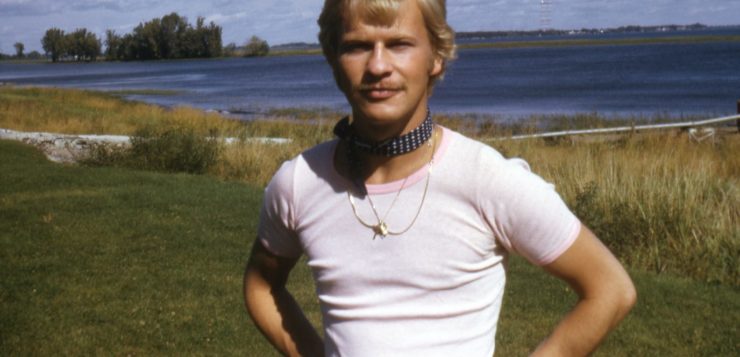IT WAS IN 1987 that Randy Shilts’ epic book on the AIDS crisis and the political response to it, And the Band Played On, hit the stands, painstakingly presenting the moral, ethical, and criminal negligence of the Reagan Administration in its response to the emerging AIDS crisis. Despite its length and the rigor of Shilts’ research, the book contained one giant erroneous theory, a bit of misinformation that became conventional wisdom and ultimately stained much of Shilts’ legacy.

This was the idea that that there was a “Patient Zero,” the first person thought to have brought HIV to North America, as California scientists had speculated. While only a minor part of the book, the media—looking for a gay vampire of sorts whom they could demonize—seized upon this idea, and stories of a promiscuous Québecois flight attendant, Gaëtan Dugas, soon popped up everywhere. Once the story made 60 Minutes, where it reached a massive audience, the highly dubious theory had become an accepted truth about the epidemic’s origins.
The Patient Zero theory has since been completely debunked, and now Toronto-based filmmaker Laurie Lynd delves into the life and legacy of Dugas, who was so unfairly maligned after dying from AIDS-related causes. The film, Killing Patient Zero, features an array of file footage and tells the story not only of Dugas’ legacy, but also what living through the early years of the epidemic was like. Lynd interviews a broad range of people—from Fran Lebowitz to Toronto writer Richard Vaughan to Dugas’ friend Rand Gaynor—in his exploration of the misguided theory and its fallout.
In the spirit of full disclosure, I must acknowledge that Lynd interviewed me for the project (having written a piece on Patient Zero for Xtra), and I appear in the film. It was a fascinating experience, prompting me to re-examine my life during those painful years. Lynd has done an exceptional job of bringing those years into clearer focus.
I spoke with Laurie in his Toronto home.
Matthew Hays: When did you first become aware of the so-called Patient Zero?
Laurie Lynd: I was first made aware of the so-called Patient Zero when I read Randy Shilts’ And the Band Played On in the late 1980’s, when I’d moved back to Toronto. Prior to that, I had lived in New York City, from 1982-1986, i.e. at the height of the worst of the AIDS years, and even though I went to fundraisers and such at Gay Men’s Health Crisis (GMHC), I think I had blinkers on for much of that time. It was reading Shilts’ (mostly) masterful book that fully woke me up to the prejudice and hatred that was inhibiting greater, quicker progress on the treatment of AIDS.
And, of course, it was in reading Shilts’ book that I first encountered Gaëtan Dugas, aka “Patient Zero.” I’m embarrassed to admit that when I first read the book, I totally bought into the Patient Zero story and Shilts’ hugely inaccurate version of Dugas. With hindsight, I recognize that my reaction was in no small part due to my as-yet-unacknowledged internalized homophobia, as well as Shilts’ persuasive writing, which we can see now clearly created “good,” “respectable” gays vs. “bad,” prodigiously sexual gays, e.g., Dugas. And internalized homophobia subsequently became a key theme for me, which I’ve been able to explore in three films, so far: The Fairy Who Didn’t Want To Be a Fairy Anymore, Breakfast with Scot, and now Killing Patient Zero.
MH: When did you start to doubt the theory? Was it John Greyson’s film Zero Patience?
LL: I had the great good fortune to meet and work with John Greyson in 1991, when I produced his remarkable short film, The Making of “Monsters” at the CFC [Canadian Film Centre]. Knowing John and then, of course, seeing his incredible film, Zero Patience, totally woke me up to the ridiculousness of the whole Patient Zero story and to the homophobia behind the need to assign blame for this disease.
MH: What was the toughest thing about making this film?
LL: I think it was revisiting and, in a way, reliving the “AIDS years.” It was upsetting to relive those awful uncertain times, when so many of our friends and lovers were needlessly dying—in the face of an establishment that didn’t seem to care.
MH: It was an incredibly harsh time, not just because of the disease, but the reaction to it by members of the political class and media.
LL: Yes. Beyond the horrors of the disease itself, I realize now that to have our sex lives discussed in the mainstream press, derided as the reason we were getting—and spreading—AIDS, effectively re-shamed me as a gay man—it subtly, powerfully complicated my sense of self-acceptance. So it was quite emotionally devastating to live in the world of this story for the intense year and a half it took to create the film. As an out gay man who lived through—and miraculously survived—the plague years, I was constantly surprised to realize how much I’d (deliberately?) forgotten about those horrible times.
MH: One thing I really liked about the film is the way you include the voices of women like Fran Lebowitz. The AIDS crisis brought queer men and women together in way that I found incredibly powerful and inspiring.
LL: I was delighted to include as many women’s voices as I could. B. Ruby Rich was top of my list as I deeply admire her work (not least because I’m grateful she included me in her seminal “New Queer Cinema” article for The Village Voice in the 1990s). Fran Lebowitz was a long shot, but I thought, Why not ask her? And someone like Priscilla Wald was a natural because of her brilliant book Contagious: Cultures, Carriers, and the Outbreak Narrative. Of course, one of the many remarkable things that came out of the AIDS years was how gay men and lesbians came together in a way they never had before. I knew from the start that I wanted to make sure the voices of women were heard in this documentary.
MH: I know Gaëtan Dugas’ family has never done media interviews. Did you reach out to them for the film?
LL: Save for a brief interview with [Québec City’s French-language daily newspaper] Le Soleil at the time of the Patient Zero story breaking in the fall of ’87, the Dugas family has never spoken to the press. I deeply admire their principled stand, particularly in light of the tell-all culture we live in now.
Killing Patient Zero is based on a wonderful book by Richard McKay, Patient Zero and the Making of the AIDS Epidemic, and Richard was in touch with the family, slowly building the trust he was able to create with them. My Québecois producing partners reached out to the Dugas family and there was a moment when it seemed as if they might participate, but in the end they decided to continue their silence, a decision that I completely respect.
It remains a concern of mine that KPZ will re-kindle, for Dugas’ family and friends, the difficult time when the “patient zero” story was first erroneously circulated in 1987. My fervent hope is that the greater good, in thoroughly rehabilitating his name, will justify the story’s reemergence.
MH: Killing Patient Zero joins a few other films, including How to Survive a Plague and United in Anger, that look back at the AIDS crisis. Why do you think there’s this renewed interest in HIV and AIDS now?
LL: I’m not sure why there is a renewed interest in hiv/aids now. I wonder if it is, in part, due to the remarkable resurgence in the popularity of documentaries, and that many queer filmmakers are recognizing how much of our collective history hasn’t been told— particularly around the AIDS years. I think it is a testament to the maturity of the queer community that there is a greater interest in remembering what we’ve been through—a shared history that can better unite us.
Matthew Hays teaches film studies and journalism at Concordia U. in Montréal.





